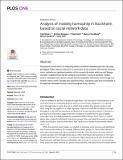Analysis of mobility homophily in Stockholm based on social network data
Author(s)
Heine, Cate; Marquez, Cristina; Santi, Paolo; Sundberg, Marcus; Nordfors, Miriam; Ratti, Carlo; ... Show more Show less
DownloadPublished version (1.299Mb)
Publisher with Creative Commons License
Publisher with Creative Commons License
Creative Commons Attribution
Terms of use
Metadata
Show full item recordAbstract
We present a novel metric for measuring relative connection between parts of a city using geotagged Twitter data as a proxy for co-occurrence of city residents. We find that socioeconomic similarity is a significant predictor of this connectivity metric, which we call “linkage strength”: neighborhoods that are similar to one another in terms of residents’ median income, education level, and (to a lesser extent) immigration history are more strongly connected in terms of the of people who spend time there, indicating some level of homophily in the way that individuals choose to move throughout a city’s districts.
Date issued
2021-03Department
Massachusetts Institute of Technology. SENSEable City LaboratoryJournal
PLoS One
Publisher
Public Library of Science (PLoS)
Citation
Heine, Cate et al. "Analysis of mobility homophily in Stockholm based on social network data." PLoS ONE 16,3 (March 2021): e0247996. © 2021 Heine et al
Version: Final published version
ISSN
1932-6203